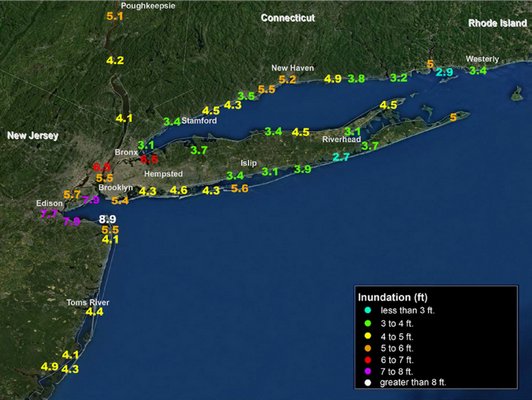
With Hurricane Harvey still on the minds of many, officials have been shoring up emergency preparedness on the East End in case a major hurricane strikes the East Coast.
Municipalities throughout Suffolk County are making final tweaks to the county’s comprehensive emergency management plan, which details specific procedures for each town.
According to Southampton Town Deputy Supervisor Frank Zappone, who is also the town’s emergency management coordinator, recent improvements include clearer lines of communication among all departments from the state level down to the town. He noted that officials from each municipality have worked with the county on the plan for the past 10 months, and said it is expected to be completed shortly. The plan also details what to do for other emergencies, like a plane crash or a major natural gas leak.
“We’ve done a good job of improving our procedures, but it’s pretty obvious that a storm like this doesn’t just affect us,” meaning only Southampton Town, Mr. Zappone said, referencing something the size of Hurricane Harvey. “If Montauk Highway is closed, everything east and west is impacted. But we’re confident that we have everything in place on a local level.”
In the event of a major storm, Hampton Bays schools would become the primary evacuation center, according to Mr. Zappone, adding that Southampton Town is talking with the Southampton School District about possibly having another center at its high school.
When Superstorm Sandy hit the South Fork in 2012, more than 65,000 homes and businesses were left without power, and a total of 550 homes were damaged in Southampton Town. Mr. Zappone said he saw that storm as a wakeup call for many residents who were not prepared for mandatory evacuations and major flooding in lowland areas.
“We have to be prepared for these kinds of things,” Mr. Zappone said. “We live in an area that’s very vulnerable. Sandy was a real eye-opener, because people were lulled into thinking, ‘Well, that’s not going to happen here.’ But it did.”
East Hampton Town Emergency Preparedness Coordinator Bruce Bates echoed Mr. Zappone’s concerns, noting that if individuals don’t make a plan for emergency situations, town efforts won’t make a difference.
“The one thing that we are constantly trying to get people to understand is that this goes on year-round,” he said, referring to hurricanes, winter storms and severe heat events. “We just want to have the general public take appropriate action to prepare. Any local government—they can be the best there is, but if we don’t have people that are preparing themselves and are willing to help out in a situation, it’s not going to be a good result.”
Mr. Bates suggested that residents prepare at the individual level by assessing whether their home is in a low-lying area and might need to be evacuated, and having necessary supplies, such as water and canned food on hand in the event that they can stay at home. In addition, they should secure their property, he said, such as by storing furniture and projects in the yard that could become airborne.
Both the Red Cross and the Federal Emergency Management Agency, or FEMA, provide “great preparedness tips that people don’t consider” on their websites, Mr. Bates said.
East Hampton High School is the primary evacuation site in East Hampton Town, and the Montauk Playhouse has also been used in the past, with other schools potentially being used as alternate sites if those facilities exceed capacity.
Hurricane season runs through the end of November, with this season expected to be above-normal in the Atlantic. Currently, East Hampton and Southampton officials are tracking Hurricane Irma, which appears poised to make landfall in Florida but could threaten other parts of the East Coast.
As of Tuesday, the town was about to check generators to ensure they were fueled up and ready for use, according to Mr. Bates.
“We start watching storms from the minute [the National Oceanic and Atmospheric Administration] classifies it as a tropical depression,” Mr. Zappone explained of Irma. “That’s one of the advantages we have that we didn’t have necessarily with Sandy. We have good advance notice.”
Both officials agreed that despite what municipalities were doing to prepare for the next storm, residents need to make a plan. Mr. Zappone also emphasized that basic homeowner’s insurance policies typically do not cover floods.
Recently, U.S. Congressman Lee Zeldin, who represents the East End, held a seminar with officials from several national emergency services like FEMA to provide residents with information about how to prepare for, stay safe during, and recover from hurricanes.
“The common message among all of the presentations was be prepared,” Mr. Zeldin said in a statement. “The key is to be informed, make a plan, build an emergency kit and get involved.”
For information about how to prepare for an emergency in East Hampton Town, visit ehamptonny.gov/240/Emergency-Preparedness. For information in Southampton Town, visit southamptontownny.gov/465/Emergency-Preparedness.